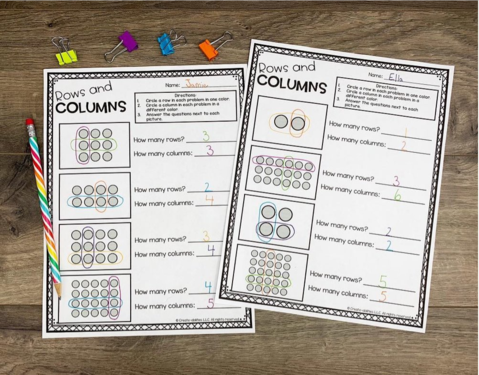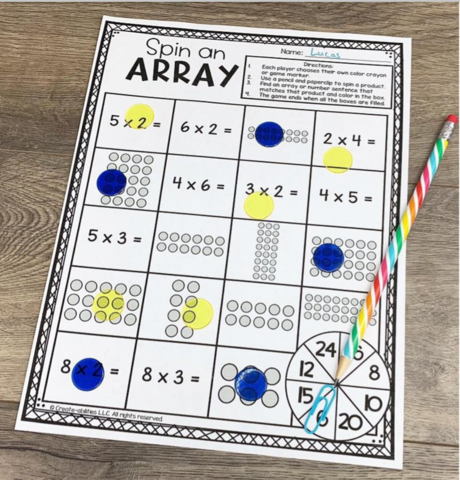
How to Teach Multiplication Using Arrays
Every subject has foundational tools that students must master before they move forward. If you don’t learn how to walk, you’ll never learn how to run, right?
This is exactly why we teach multiplication with arrays.
You probably already know that arrays can build a deep understanding of multiplication and division. But we cannot underestimate their importance as a foundational building block for more advanced concepts.
Bottom line: Arrays are incredibly important. Possibly more important than you realize. Let’s explore…
In this post, we’re going to cover a few techniques to help students solidify their knowledge of arrays. And we’re also going to talk about how to build on what they know to easily learn multiplication and division.
Why teach multiplication with arrays
It’s true that you can teach multiplication without arrays, but it ends up being more about memorization than understanding. And we all know that memorization is boring.
Without arrays, something like 3×7 is an abstract concept.
Arrays show students that 3×7 has meaning. Arrays offer a visual aid that students can create on their own – once they have the right tools.
With a visual understanding of the concept, students gain a deeper understanding of multiplication.
Teaching the basics of arrays
With hands-on motivating array activities, we teach students what arrays are and why they’re important. And we’re going to walk you through the steps with free printable lessons, so you can teach these lessons too.
Before we even jump into the lessons, explain arrays to your students in detail. Some may have an understanding already, and that’s okay, but it’s so important that each student understands the term before we delve into the lesson.
This quick lesson may include things like:
- What does “x” mean?
If you ask students what the “x” means in an equation, they may say “times.” But instead, we want them to start thinking of “x” in terms of “groups of.” So, 3×3 becomes 3 groups of 3.
- Why does order matter?
Some people may argue that order isn’t necessary if the answer will be the same anyway. Although there’s some truth to that, we want to focus on teaching the foundations of math that will help students tackle more complicated equations later.

Lesson 1: Rows and columns
In the next lesson, we teach kids about rows and columns. You almost cannot overdo this. Without a solid understanding of rows and columns, students won’t get the full benefit of using arrays.
These free downloadable posters are great teaching tools to help deepen a child’s understanding of arrays and how they can be used. Have them practice circling rows an columns to get familiar with these concepts.

Lesson 2: Multiplication arrays worksheets
After students get to the point where they’re circling columns and rows in their sleep, it’s time to dig a little deeper into arrays with a worksheet.
As we work through this, designating rows and columns will become second nature. Before we delve further into arrays and equations, there should be no question about which is a row and which is a column. The more practice you can give them, the more powerful it will be.
Multiplication = repeated addition
This is a great time to talk about how multiplication is nothing more than repeated addition. It’s not a new concept to students, so it shouldn’t be intimidating. Multiplication is just a faster way to add.
Now, kids can start breaking numbers out into equal groups to get a feel for multiplication. This is also a great segue into using arrays.
At this point, kids can start mapping out arrays on their own. Using this free worksheet, task each child with creating arrays of varying size. Once they create the arrays, they can use multiplication to figure out the total number of objects in each array.
Practice in partners or individually.

Lesson 3: Arrays in the real world
Once students have an understanding of arrays, challenge them to find real world examples. They’ll start seeing arrays in a box of donuts, carton of eggs or on a windowpane. With these real-world examples, students can practice multiplication again and again.
These multiplication arrays worksheets help illustrate how there are arrays everywhere.
This one also makes a fun bonus question or homework assignment.

Arrays with mixed media
If you think your students need to be engaged further, break out the playdough. Don’t worry that they’re too old for it. Hands-on experiences like these help drive the point home while giving students a break from the monotony of textbooks and worksheets.
This set of worksheets provides ideas for using different methods and materials to create arrays. Give students graph paper or grid paper and let them experiment over and over again.
This practice can also help kids hone in on fine motor skills and alignment.
Lesson 4: Teaching division with arrays
By now, students should have a solid understanding of creating and recognizing arrays. But we know that these aren’t standalone facts. Our kids should too.
That’s why the next lesson focuses on playing with multiplication and division to understand their relationship.
Students may well understand that 4 x 4 = 16. But they also should learn the relationship between these numbers and why 16 / 4 = 4.
This is the puzzle piece that helps students gain a deeper understanding of foundational math concepts. If we can get this part to click, they’ll have a better chance of understanding more complicated equations later on.
But this clearly isn’t a good starting point. If you jump to this lesson before students are ready, they aren’t likely to understand these important relationships. This is why we start with circling rows and columns and creating arrays.
Here, you can practice multiplication and division using arrays. When you practice multiplication and the reverse division on the same array, it drives the concepts home in a more powerful way. Show how multiplication and division are connected.
This paves the way for learning about more advanced topics like areas and perimeters.

Bonus assignment: Fun with Arrays
Now that students should have a solid understanding of arrays and how to use them for multiplication and division, we can have some fun. We’re also including some printable books and games that can help kids get better acquainted with using arrays to solve math problems.
- Books – Personalize each student’s experience
- Spin on an array – Make a fun game out of learning arrays. Let students work together or on their own.
- Array matching game
- Amazing array banners – way to tie it all together to illustrate how multiplication and division are tied together.
Blog Categories
Meet the author


